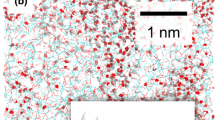Summary
The equation of viscosity during water desorption is derived by use of the viscosity equations by Eyring and Doolittle which represent the viscosity in a steady state of moisture. Their equations give the same formulation as is represented as follows:
where η (t) is the viscosity during water desorption, ηe is the viscosity in a steady state of moisture, n ∝ 1/f; f is the free volume fraction, F(t) is the desorption rate. On the basis of this viscosity equation, the entropy change for the creep in a steady state of moisture and that in a water desorption process are calculated. The difference of the entropy between both the state after an extend time, t, is represented by the following equation:
where ΔS is the difference of the entropy, σ0 is stress, K is constant, M (t) is the moisture change, T is the absolute temperature. The entropy decrease in a water desorption process is more than that in a steady state of moisture. This equation suggests that molecules or flowing segments in wood substances rearrange more orderly during water desorption. This leads to the conclusion that the excess entropy decrease in a water desorption process is one of factors contributed to the deflection recovery in the subsequent water adsorption process for the mechano-sorptive creep.
Similar content being viewed by others
References
Doolittle, A. K.; Doolittle, D. B. (1957) Studies in Newtonian Flow. V. J. Appl. Phys. 28: 901–905
Eyring, H.; Halsey, G. (1946) Mechanical properties of textiles. III. Textile Research J. 16: 13–25
Ferry, J. D. (1970) Viscoelastic Properties of Polymers. John Wiley & Sons Inc. New York, N.Y.; ibid.Ferry, J. D. (1970) Viscoelastic Properties of Polymers. John Wiley & Sons Inc. New York, N.Y. 2nd ed.
Grossman, P. U. A. (1976) Requirements for a model that exhibits mechano-sorptive behavior. Wood Sci. Technol. 10: 163–168
Halsey, H.; White Jr., H. J.; Eyring, H. 1945a Mechanical properties of textiles. I. Textile Research J. 15: 295–311
Halsey, H.; Eyring, H. 1945b Mechanical properties of textiles. II. Textile Research. J 15:451–459
Hunt, D. G.; Shelton, C. F. (1987) Progress in the analysis of creep in wood during concurrent moisture change. J. Mater. Sci. 22: 313–320.
Leicester, R. H. (1971) A rheological model for mechano-sorptive deflections of beams. Wood Sci. Technol. 5: 211–220
Mukudai; Yata (1986) Modeling and simulation of viscoelastic behavior (tensile strain) of wood under moisture change. Wood Sci. Technol. 20: 335–348
Mukudai; Yata (1987) Modeling and simulation of viscoelastic behavior (bending deflection) of wood under moisture change. Wood Sci. Technol. 21: 49–63
Mukudai; Yata (1988) Verification of Mukudai's mechano-sorptive model. Wood Sci. Technol. 22: 43–58
Nakano, T. (1994) Mechanism of thermoplasticity for chemically modified wood. Holzforschung. 48: 318–324
Nakano, T. (1994) Theoretical description of creep behavior during water desorption. Holzforschung. (in press)
Schniewind, A. P. (1966) On the influence of moisture content changes on the creep of beech wood perpendicular to grain including the effects of temperature and temperature changes. Holz. Roh-Werkst. 24: 87–98
Takemura, T. (1966) Plastic properties of wood in relation to the non-equilibrium states of moisture content. Mem. Coll. Agric. Kyoto Univ. No. 88: 31–48
Takemura, T. (1967) Plastic properties of wood in relation to the non-equilibrium states of moisture content (continued). Mokuzai Gakkaishi. 13: 77–81
Takemura, T. (1968) Plastic properties of wood in relation to the non-equilibrium states of moisture content (re-continued). Mokuzai Gakkaishi. 14: 406–410
van der Put, T. A. C. M. (1988) Theoretical explanation of the mechano-sorptive effect in wood. Wood & Fiber Sci. 21: 219–230
Author information
Authors and Affiliations
Rights and permissions
About this article
Cite this article
Nakano, T. Viscosity and entropy change in creep during water desorption for wood. Wood Sci.Technol. 30, 117–125 (1996). https://doi.org/10.1007/BF00224963
Received:
Issue Date:
DOI: https://doi.org/10.1007/BF00224963




